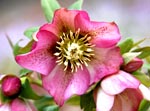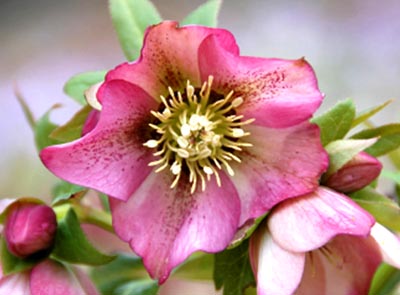How to grow hellebores
You need to start with two really top-notch plants, says nurserywoman Carol Klein who reveals her top tips to growing hellebores


What is it about hellebores that make them so alluring? Part of it is to do with when they put on their best show. Perhaps if they flowered in the midst of the summer display they might go unnoticed. They are not tall plants, and none could ever be accused of being flamboyant. Their ‘flowers' are composed of sepals rather than petals; these last for months and eventually all fade to a subtle green. The range of colour when they are in flower is staggering from immaculate white to virtually black and in between through pinks, purples, clarets, yellows and greens. Some have the subtlety of a wood pigeon's breast, others the depth and strength of rich red wine.
These plants hang their heads demurely so that all we see at first is the back of their flowers. This is what makes them so mysterious and unpredictable. Half their charm is this secrecy and everyone who grows hellebores understands the joy of gently turning up their flowers to appreciate the subtleties within. Sometimes there are spots and blotches arranged in symmetrical patterns, sometimes subtle shading with perhaps a picotee edge. At their centre all have a breathtaking arrangement of nectaries and a boss of golden stamens topped with pollen-rich anthers, which makes them easy plants to cross. There is no time like the present!
It's only worth trying it if you start with two really top-notch plants. The black lid of a biro rubbed smartly on my jeans produces static that allows me to pick up pollen efficiently, and can be washed and dried if I want to make more than one cross. Using this lid, I take the pollen either direct from an open flower or, if I want to make sure its pollen is fluffy and potent, I float the flower in shallow water overnight indoors. However I collect pollen, it is dabbed onto the anthers of a flower on the mother plant by carefully opening a fat, virgin bud and depositing the collected pollen onto the central stigma.

I close the petals and, if possible, repeat the process on three separate days. Sunny days are best, but at this time of the year three consecutive sunny days might be too much to hope for! Once pollinated, I loosely tie a bit of coloured wool (I use my grandma's embroidery silks) behind the flower and stick a bit of the same wool onto the page of a notebook and make a careful record of both parents alongside. Come late May or early June there should be fat pods full of seed and there will be a record of how each cross was made.
I try to catch seed before it falls to the ground, sowing it straightaway on the surface of gritty, loam-based seed compost, covering it with grit, watering from underneath and leaving the pots outside. The pots can be covered to protect seeds from the predations of mice; I'll check regularly, and when the first seed leaves start to emerge, I'll remove any covering. When seedlings develop a few leaves, I separate them and prick them out into individual pots. Potting them on regularly produces sturdy little plants. When it's time for my new seedlings to face the big wide world, I plant them out in dappled shade. It will often take two, or even three, years before they flower, but when they do, I'll keep those that show star quality.
to Country Life and save over £50 a year
Sign up for the Country Life Newsletter
Exquisite houses, the beauty of Nature, and how to get the most from your life, straight to your inbox.
Country Life is unlike any other magazine: the only glossy weekly on the newsstand and the only magazine that has been guest-edited by HRH The King not once, but twice. It is a celebration of modern rural life and all its diverse joys and pleasures — that was first published in Queen Victoria's Diamond Jubilee year. Our eclectic mixture of witty and informative content — from the most up-to-date property news and commentary and a coveted glimpse inside some of the UK's best houses and gardens, to gardening, the arts and interior design, written by experts in their field — still cannot be found in print or online, anywhere else.
-
 Six rural properties with space, charm and endless views, as seen in Country Life
Six rural properties with space, charm and endless views, as seen in Country LifeWe take a look at some of the best houses to come to the market via Country Life in the past week.
By Toby Keel
-
 Exploring the countryside is essential for our wellbeing, but Right to Roam is going backwards
Exploring the countryside is essential for our wellbeing, but Right to Roam is going backwardsCampaigners in England often point to Scotland as an example of how brilliantly Right to Roam works, but it's not all it's cracked up to be, says Patrick Galbraith.
By Patrick Galbraith